Lunar New Year Around Asia

Lunar New Year, an event celebrating the first new moon of the year is celebrated all over the world, while most commonly associated with Chinese culture, did you know that the same is greeted in the Philippines, as Tet in Vietnam, and as Seollal in South Korea?
Bahay Tsinoy, Museum of Chinese in Philippine Life, the Korean Cultural Center in the Philippines, and the Embassy of Viet Nam shared to Asia Society Philippines how the annual Spring Festival or Lunar New Year is celebrated in their respective cultures.
Learn more about them below:
The Tsinoy (Filipino-Chinese) New Year
Beyond Tikoy and Charms
Meah Ang See, Bahay Tsinoy, Museum of Chinese in Philippine Life
The Lunar New Year abounds with symbolisms, of family and unity, growth and prosperity, friendship and harmony. Beyond these festive celebrations, tikoy friendships and attractive charms, let us remember to share the true meaning and purpose of the Spring Festival.
It is the time of rebirth and renewal. After the harsh and bitter cold of winter is the promise of warmth and growth of spring. Beyond new clothes and shoes, abundant lauriats and noisy festivities, beyond the superstitions and the old traditions, the new year brings another chance to be renewed, to do better, to pray for good harvest, good weather and goodwill among men.
Kiong Hee Huat Tsai 恭喜發財!
Go out into the streets of major urban centers in the Philippines and you would mostly see signs that have the Chinese characters 恭喜發財 and Kong Hei Fat Choy. Here lies the disconnect among establishments promoting Chinese New Year and the local ethnic Chinese community. Ninety percent of Tsinoys or Chinese Filipinos hail from Fujian province and we speak Hokkien or Minnan. For the new year, we greet each other Kiong Hee Sin Ni (恭喜新年) or Kiong Hee Huat Tsai – the Hokkien version of Kong Hei Fat Choy, which is Cantonese. Using the Cantonese version, though, is more familiar to many, including Filipinos. And for stores, that would mean more sales of CNY-themed items.
Celebrating Chinese New Year as a holiday was not so popular until the late 1990s to early 2000s. Eventually, it developed into a national holiday granted by presidential decree. Much like how Christians lament the commercialization of Christmas, Chinese New Year in the Philippines is fast losing that battle as well. In many lectures I give for CNY, I often compare the sentiments of CNY to Christmas. During Christmas, the entire family comes together. Doesn’t matter where you are, you come home or you made long distance calls (Gasp! Yes, I’m that old), or now, have an online family celebration with everyone in the family and extended family attending. No excuses. In China, it is a weeklong holiday so that relatives from far away could have the time to travel back home.
There is no specific attribution to the popularity gained by the CNY celebrations. What we know is that tikoy (sweet rice cake) has become heavily coveted, a ton of lunar new year or Chinese-themed items come out for sale, and feng shui “masters” (aka charlatans) come out of the woodwork with various predictions for the coming year and even contradicting predictions for the same set of conditions.
Rituals
It is important to visit the oldest and most senior members of the extended families. Members of the family gather for a reunion dinner on Chinese New Year’s Eve. In the Philippines, most family members bring their favorite dish to share with others. It is a time for reminiscing, for laughter and for deepening family ties. It is also traditional for every family to thoroughly clean the house, to sweep away any ill-fortune and to make way for positive energy and luck.

Young children, meanwhile, look forward to receiving 红包 angpao or red envelopes filled with money (not to be confused with ampaw, which is the rice crispy snack with a hollow center). The angpao is to ensure that one has money entering the new year. Angpao etiquette is drilled into us from early childhood. Thank the giver profusely. Never open the envelope during the event. You open it and count your blessings in private. For some families, it is even impolite to stare at the angpao! As soon as it touches your hand, say your thanks, put it in your pocket and not even glance at it. Angpao money is often also not to be spent immediately. You keep it until you really, really need it. Or if your parents refuse to buy you a toy that you really, really want, you could then negotiate to buy it with your angpao money.
Part of the money-sense tradition is to also make sure that all debts are paid before the year ends 不欠過年. After all, you don’t want to start the year with a mountain of debt. New beginnings for the new year. On a side note, I love this tradition because it also helps control borrowing during the year. One only borrows enough to make sure that all debts could be paid off at the close of the year.
Lion dance troupes are invited as a symbolic ritual to usher in the Chinese New Year as well as to evict bad spirits from the premises. On the week of CNY, we would often see troupes in malls and streets performing this ritual to bring luck to the shops in the coming year. At dance intervals, the lion dancers sweep up to grab 红包 angpao (red money envelopes) that shopkeepers hang at the top of their door frames.

Food
Tikoy, noodles and dumplings of various kinds, usually made of glutinous rice flour, are indispensable for every household because rice is a staple food and the stickiness ensures that the family stays together. Just like Filipinos, the Chinese give a lot of importance to the New Year as a time of reunion and gathering. The stickiness and sweetness of rice cakes symbolize the wishes for a sweeter life of family members who always stick together.

Through centuries of interaction between Chinese and Filipinos, Chinese food in the Philippines has evolved from its original Chinese Hokkien version or Cantonese version to a Filipinized version suited to the Filipino palate. Lumpia and pancit are classic examples of this evolution. While both admittedly of Chinese origins, we have taken them for our own and made them richer with variations galore - lumpiang shanghai, sariwa, ubod, prito, pancit palabok, habhab, bato, luglug, malabon, canton, bihon.
Contrary to popular belief though, putting 12 round fruits on the table for the new year is not of Chinese origin. The Chinese in the mainland put fresh food on the table, fruits and vegetables. In some regions, they put fresh flowers. The 12 round fruits tradition most likely stemmed from a Spanish tradition of eating 12 grapes at the turn of the year, one grape for each stroke of midnight. Because we have no grapes here, maybe the Spanish of old just ate any round fruit they could get their hands on. There is, of course, no records of how and when we began this tradition, and so to the confusion of the mainland Chinese, we eat 12 round fruits and wear polka dots as symbols of luck.
Symbols
In Hokkien-speaking countries, the pineapple has become a symbol for prosperity. The common Mandarin name for pineapple is 菠蘿 bo luo. Hokkien speakers use an older name for pineapple 鳳梨 feng li in Mandarin, and ong lai in Hokkien. Ong lai is the same sound as 旺來 which means fortune comes. Like wearing dotted clothes for the new year, luck can only bring us so far. As Christians say, nasa Diyos ang awa, nasa tao ang gawa (God gives mercy to those who help themselves).
Another popular homophone involves fish, or 魚 yü. The word sounds like the last character of the Chinese’ wishes for the coming year - 年年有餘 nian nian you yü, which means every year there is more than enough. As the planting season begins in the Spring, farmers hope for a more than bountiful harvest that will carry them on for the entire year and beyond. This saying is more than poignant for Chinese Filipinos, especially our grandparents who started their lives here with nothing. The desire for a bountiful table is directly related to the desire to no longer return to times of hunger. Part of this tradition is very similar to the Filipino habit of ‘walang sayang’ – no waste. We finish every last bit of food on our plates, and keep everything else as leftovers for the next day, even if it’s just two tablespoons of rice.
Feng Shui
I’m not at all an expert in 風水 feng shui. What I do know is that it is the harmony of man and nature. Fengshui Masters are those who study this balance. I hear this adage often: 天時地利人和 Heaven’s time. Earth’s providence. Man’s will. One’s destiny is given by heaven and cannot be changed. The earth gifts us with its resources, which Man may use wisely or foolishly.
天時不如地利 , 地利不如人和 Man’s will triumphs over the earth’s providence. Earth’s providence triumphs over Heaven’s time. The heavens bring typhoons over the earth. The earth has provided mountains and trees as barriers to the typhoons. Man wisely protects what the earth has endowed, thus saving himself from the fury that heaven and earth release. (Or conversely, man foolishly exploits what the earth has provided and we now have climate change).
In the same vein as beginning the year with harmony, it is no longer good fengshui to set off firecrackers during the new year. The firecracker tradition began, as legend goes, with a ferocious monster called Nian, which looted and hurt people at the turn of each winter. The people learned that Nian was scared of the color scarlet, noise and fire. Scientifically speaking, the Nian of old are most probably wild animals that hibernated through the winter. Waking up hungry in Spring, they roamed the villages looking for food. People scared them away by burning bamboo stalks whose crackle and flames frightened Nian. People traditionally wore red during the new year, and consequently, while probably unrelated, red has become part of the power that scares off Nian. Families would hang red banners, and light their lamps the whole night through, awaiting the Chinese New Year.
Today, with no wild animals roaming villages, exploding firecrackers simply courts disaster - limbs are injured; fingers cut off; houses burn down - and we all greet the new year with thick smog making people sick from pollution, contributing to global warming and climate change – creating disharmony between man and nature.
The Lunar New Year abounds with symbolisms, of family and unity, growth and prosperity, friendship and harmony. Beyond these festive celebrations, tikoy friendships and attractive charms, let us remember to share the true meaning and purpose of the Spring Festival.
It is the time of rebirth and renewal. After the harsh and bitter cold of winter is the promise of warmth and growth of spring. Beyond new clothes and shoes, abundant lauriats and noisy festivities, beyond the superstitions and the old traditions, the new year brings another chance to be renewed, to do better, to pray for good harvest, good weather and goodwill among men.
The Korean Seollal
Celebrating Seollal
Korean Cultural Center
Although how we spend Seollal has become different from back then, our willing to continue the tradition and to remember our ancestors remain the same as then like how Koreans try to keep traditions against Japanese colonial rule. And this will keep Seollal as one of the biggest Korean holidays in the future.
설날 (Seollal) or Korean Lunar New Year is one of the biggest holidays in Korea. During this time, many Koreans visit their family, perform ancestral memorial service, eat foods, wear hanbok, and play folk games. Even though its vibe has been changed after the pandemic, still it’s the one of the most awaited days of the year.
Why do Koreans celebrate new year by Lunar calendar?
Until the mid-20th century, Korea was primarily an agricultural society, and the seasonal rhythms of daily life were organized by the lunar calendar. Because farming was hugely important for the subsistence of the members, such society developed a great variety of semi-religious events intended to pray for health, luck, good harvest, and abundant food. Those events gradually evolved into communal celebrations and festivals like Seollal.
What do Koreans do during Seollal?

If you like to watch K-Drama, I am pretty sure that you have seen them doing unique rituals on someone’s death anniversary. Truth is, Koreans perform several types of ancestral memorial services in a year to express gratitude to ancestors and remember them. 차례 (Charae) is one of them done on special occasions like Seollal. In the early morning of Seollal, all family members gather and do the relatively simple rituals to ancestors, wishing peace and prosperity for the year.
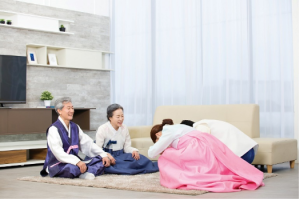
Also, younger people make a deep traditional bow to their elders wishing them a happy new year, which is called 세배 (sebae) or New Year’s bow. Then, the elders typically reward this gesture by giving New Year’s gift money to them (Usually, it’s only for children). When I was little, I remember I was bragging about how much money I was rewarded to my friends. If I get lucky, I was even able to receive the gift money from my parents’ friends who I ran into from their hometown. So, why not call it a most awaited holiday?

If there is one thing you shouldn’t miss during this holiday, it is the food. The most representative Seollal dish is 떡국 (tteokguk) or rice cake soup. The white soup and the white tteok or rice cake symbolize forgetting all the bad things from the previous year and starting afresh for the new year. Also, 가래떡 (garaetteok), general types of tteok used in the soup symbolizes long life due to its long shape. Believe it or not, few people still believe that we can grow one year older after consuming a bowl of tteokguk on the new year day.
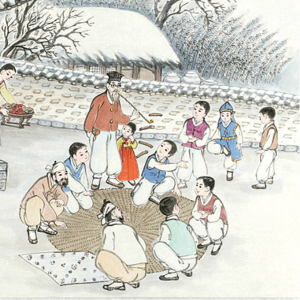
No matter how tired it is going to one’s own hometown and beating all the traffic, it’s worthy once we meet family, relatives and friends after a long time. We spend time saying hello and delivering blessing words for the new year. Also, folk games fill up the time that might be boring or awkward. One of the typical folk games played during Seollal is 윷놀이 (Yutnori). The word Yut translates to sticks and Nori means game. In Yutnori, four tokens are moved around a cloth game board. Instead of modern dice, 4 yut sticks, each having one flat side and one round side, are cast to control the movement of the tokens. Trust me, this is such a nice ice breaking game.
Seollal, Then and Now
As the country developed, the once agricultural society has transformed to an industrial society and it also changed the form of family from extended family to nuclear family. It also affects the way of spending the Seollal. Some no longer wear hanbok, some streamline the event or even spend the holidays abroad rather than seeing each other. Furthermore, 2 years of pandemic has been limiting the family gathering during the holidays.
Nevertheless, I believe that as long as the most important thing of this holiday doesn’t fade away, Seollal will stay longer with us. It’s the respect to ancestors and traditions.
In Japanese colonial period, Koreans were forced to celebrate solar new year’s day saying the lunar new year is the ‘old’ to belittle the Korean culture. Unfortunately, even after the colonial period, Korean government sticked to this system. However, people still recognized the lunar new year as the traditional new year’s day and visited their hometown on that day. Accordingly, in 1989, lunar new year’s day regained its name Seollal and the public holidays were also expanded to 3 days. (the day before, the day, and the day after)
Although how we spend Seollal has become different from back then, our willing to continue the tradition and to remember our ancestors remain the same as then like how Koreans try to keep traditions against Japanese colonial rule. And this will keep Seollal as one of the biggest Korean holidays in the future.
The Vietnamese Tet
Celebrating Tet
Embassy of Viet Nam, Philippines
With a new year upcoming around the air, the true happiness fills each corner with everyone’s prompting preparation towards the Tet holiday. We would love to see each other feel exhilarated with their promising new year for a greater mountain of luck. Whether Tet in Vietnam or anywhere in Southeast Asia, this traditional holiday is greeted and filled with actual love and fulfillment.
Why is the Lunar New Year celebrated in Viet Nam?
Lunar New Year, called Tet in Vietnam, is the biggest holiday. It is the holiest time in Vietnam when people come back to their hometown for the family’s reunion. It is also when the weather reaches its most beautiful time in a year.
Many people think that most Southeast Asian countries celebrate the Chinese New Year. In fact, however, it is different. Only does Vietnam hold the Lunar New Year because Vietnam seems to be one of the oldest agricultural countries in Southeast Asia and the time of a Tet falls actually on the first day of a new cultivation cycle. Therefore, Tet is celebrated to sum up a harvest year and welcome new season with the hopes of more abundant crops
At present, Tet is celebrated to reunite families. Everyone working far from their countryside wants to come back home to meet their loved ones after a year of working hard and separation.
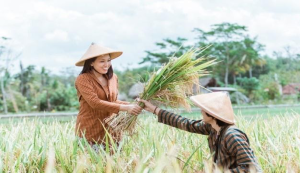
What is its historical significance?
As the longest public holiday, Tet in Vietnam delineates an ambient change of the atmosphere with a variety of festivities. One thing that makes Tet in Vietnam so different from Chinese New year is: Vietnamese people have a custom of first footing and planting the “Neu tree”. The tree is originally a five meters tall bamboo shoot with the chop hanging many luck-seeking things. They include votive papers, amulet exorcism or liquor bottles made of straw to ward off the evil spirits that harass the home of living people. However, the custom is usually implemented in urban areas or in historical places in Hanoi.
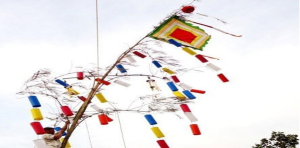
Peach and apricot trees are the ones that people believe could bring prosperity and fortune to the whole family for a new year. Normally, Northern Vietnamese prefers peach blossom while apricots are more popular in the South. Vietnamese people consider that Tet is not yet coming back without the appearance of those symbolic trees at every home or in gardens. Nowadays, people also have kumquat as a symbol of luck and prosperity.
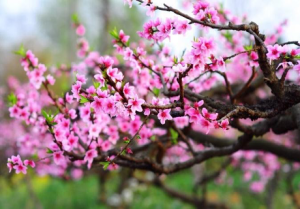
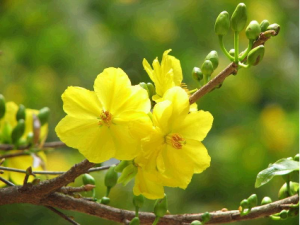
In China, people will conceptualize apricot flowers, narcissus, and eggplants. Those trees represent luck, fortune, and health accordingly. They have the meaning of praying for ravishing luck, fortune and health in Chinese New Year.
Besides peach, apricot and kumquat trees, Banh Chung, Banh Tet, Banh Day are three typical dishes in every family’s meals in Tet holiday. Considered as the soul of Tet in Vietnam, people feel the smell of Tet whenever they see Banh Chung which are made by the old, surrounded by a lot of children waiting to receive a small treat . The truth is one person cannot enjoy the Chung cake entirely by himself/herself. It is for sharing. Usually, whole family members will share it together while they are having a meal or having an intimate talk around the warm fire, telling each other their stories in the old year and also spending the best wishes in the coming New Year.
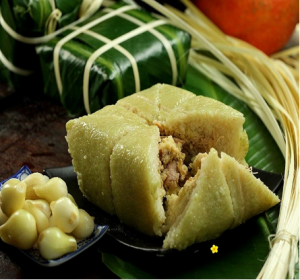
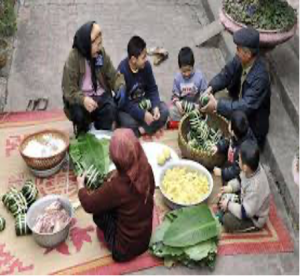
Vietnamese food is not only food, but it also presents culture. Nowadays, some urban families, especially nuclear families, don't have time to wrap the Banh Chung by themselves anymore. But they can buy it instead because Banh Chung is still an irreplaceable food of Vietnamese people on the Tet holiday.
How is Tet celebrated?
Tet can be a very exciting time. It is also the busiest time of the year. Millions of people will be moving throughout the country, returning to their home villages to share reunions with friends and families.
In general, Tet can be divided into 3 periods, known as Tất Niên (before New Year’s Eve), Giao Thừa (New Year Eve) and Tân Nien (The New Year Days).
Before the New Year’s Eve
This period begins one or two weeks before the actual celebration. The general atmosphere leading up to Tet is in the bustle of shopping, decorating the home, cooking traditional Tet food and waiting for relatives to return home. Especially, On the 23rd of the last month in the lunar calendar, Vietnamese people prepare the traditional offerings and especially the carps to regale the gods and goddesses living at their house all over the year. Then they will release the carps into the river so they will be used by the Gods as the transportations to come to heaven, according to the legend. At heaven, they will report everything happening all around the year of their family to the King of heaven. They will come back on the last day of the year to celebrate the Tet holiday with the host. The carps then become the dragons. Tet Ong Cong, Ong Tao of Tet holiday 2022 is on January 25th.

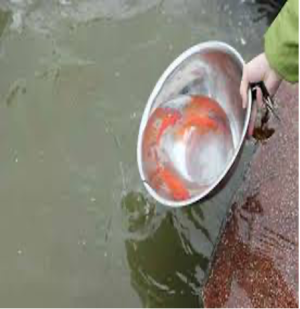
Home decoration has become a custom of Vietnamese to welcome a new year. Tet holiday is also called by a jolly name “house-cleaning festival”. A week before the Tet festival, all members of the family clean the house, the garden, the altars, and do Tet holiday decorations. Broken things will be repaired, old things will be replaced. Clothes and decorations such as lanterns and lights will be bought. All those preparations have the same purpose – to be the best to welcome the Tet festival and to receive luck as well as fortune.

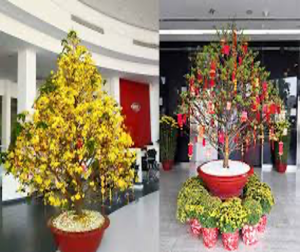
In the New Eve
New Year’s Eve is considered a sacred moment. Vietnamese people are willing to forget all past problems and quarrels to start a new year. Historian Duong Trung Quoc said: “The lunar new year festival means a new beginning. The night of the last day of the lunar year is a moment of change between heaven and earth and among gods and people themselves. In the new year people are one year older, have more memories and head for the future. People consider New Year’s Eve a sign of the future.”
On Tet Eve, the young often go out to watch the Tet holiday firework performance while the elderly and adults stay at home making offerings of pig head, boiled chicken, rice, and salt for outdoor worshipping to the Gods and indoor one to the ancestors. They will pray for a new year of luck, health, and fortune to every family member.


After that, the young return home and become the first one to come to the house in the lunar new year. It is believed that the wishes of that person for the host will come true. Then everyone gathers again to drink some alcohol or juice. Then the wishes, as well as plans of every person for the new year, will be shared with others.
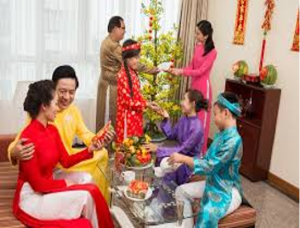
The first days of Tet
Tet in Vietnam traditionally lasts for three days. People often stay at home to welcome guests to their houses or go to their relatives and neighborhood houses. The elderly will receive the Tet holiday’s gifts and wishes for health, the adults will be given the ones for fortune and success while the young and children will get lucky money. Laughs and talks appear everywhere on the Tet holiday these days. Alongside these, Vietnamese people often go to pagodas. By donating money and asking for letters, they will receive several lucks and fortunes.
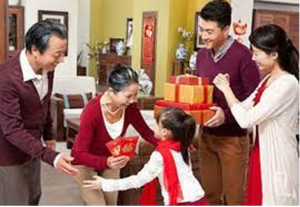
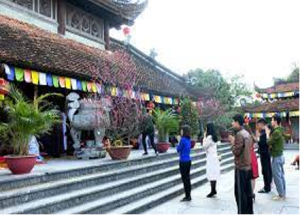
This is a meaningful occasion for the family to get closer and understand each other at the end of the year. However, the customs of the celebration have evolved at this time. People in the family have a tendency to go somewhere and see this holiday like a vacation. It is a modern way to enjoy Tet. Most of the young and old plan to travel to other places as a long vacation to refill their energy. Then they can start a new year with excitement.
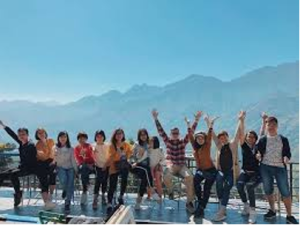

What is the spirit of the Lunar New Year celebration in community?
With a new year upcoming around the air, the true happiness fills each corner with everyone’s prompting preparation towards the Tet holiday. We would love to see each other feel exhilarated with their promising new year for a greater mountain of luck. Whether Tet in Vietnam or anywhere in Southeast Asia, this traditional holiday is greeted and filled with actual love and fulfillment.